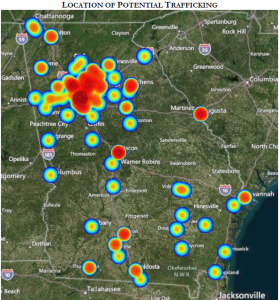
On January 1, 1863, President Abraham Lincoln abolished slavery in the United States with the Emancipation Proclamation. More than 150 years have passed since that day, and organizations like the End It Movement (EIM) are still trying to eliminate modern-day forms of slavery in Atlanta and in cities worldwide.
The statistics:
27 MILLION… This is the number of people that are currently enslaved worldwide.
30… Every 30 seconds, someone is enslaved and and forced into the world of human trafficking
200,000… The number of slaves that exist in the United States.
50… Fifty percent of all slaves today are victimized children.
14…This is where the city of Atlanta ranks nationwide as a major hub for sex trafficking. (Source: enditmovement.com)
Human trafficking is the terminology used today to describe modern-day slavery. According to the U.S Department of Health & Human Services (HHS), human trafficking exists in two basic forms: labor trafficking and sex trafficking.
According to the HHS, sex trafficking is the most common form of slavery implemented today. Every day, more people are abducted and forced to become sex slaves. The city of Atlanta is a major supplier of these slaves to interested parties.

For the first half of the 2013 year, the National Human Trafficking Resource Center (NHTRC) recorded 85 potential cases of human trafficking in Georgia. Most of those cases were concentrated in the city of Atlanta and 67 of the 85 cases were sex trafficking cases.
Students at Georgia State who are inspired to take action against sex trafficking on and around their campus can join Manumission, an organization with 48 members that works to educate students about child sex trafficking.
“Our primary goal is use different perspectives to educate students, faculty, and staff about Commercial Sexual Exploitation of Children (CSEC) in Georgia,” Anh Ly, president of Manumission, said. “We host Speaker’s Series every month. In the past we welcomed State Attorney General Sam Olens, Senator Renee Unterman, Special Agent Sara Thomas from the GBI, Brandy Bazile from the Georgia Care Connection, Katrina Owens, a CSEC advocate and survivor herself, and many more.”
Atlanta is a hotspot for CSEC and the 14th largest sex trafficking city in the U.S. Ly said that Manumission’s secondary goal is to promote measures to eradicate slavery from the city of Atlanta.
Anti-trafficking student organizations like Manumission at universities across the city of Atlanta cannot eliminate slavery alone. The End It Movement is the ongoing cumulative effort of ten organizations attempting to end slavery worldwide. The movement originated on Dec. 21, 2012, and has since grown in size and influence.
According the EIM, since 2007, an average of 17,500 people are forced into slavery around the U.S. annually. Half of these new slaves are children.
According to Bryson Vogeltanz, the Chief Steward of the End It Movement, the first step in the movement’s mission is raising awareness for slavery worldwide.
“Awareness is the most important step in the process of this movement,” Vogeltanz said. “Every month, we design a symbolic protest for freedom fighters to participate in. In fact, there is a symbolic protest commencing on the 27th of this month.”
According to Vogeltanz, these monthly activities are designed to raise awareness and help expedite the freeing of slaves. This is the activity posted to the website this month:
“This February 27th, join us and other Freedom Fighters from around the world as we SHINE A LIGHT ON SLAVERY. Draw a RED X on your hand. Tell your world that slavery still exists and YOU WON’T STAND FOR IT.”
According to Vogeltanz, while none of the organizations in the EIM are based in the city of Atlanta, representatives within the movement have many connections with non-profit organizations that are based in the metro area.
“Because the coalition is made up of 10 organizations, we cannot have a non-profit in every city,” Vogeltanz said. “That is why our number one goal is spreading awareness, and this month’s symbolic protest helps us do that. Even though our coalition has no members directly based in the city of Atlanta, anyone in any city around the world can participate in the protests.”
There are still other non-profit organizations doing work within the metro-Atlanta area. One of those non-profits is called Wellspring Living.
Created by Mary Frances Bowley in 2001, Wellspring Living has created four restoration programs in Georgia for survivors of sexual exploitation and abuse. The most recent program, Empowered Living, was established in 2012 and is designed for girls between the ages of 17 and 22 who were sex trafficking victims.
Each of the 10 organizations that are directly connected to the EIM serve a different role in the movement’s efforts to eradicate slavery. Together, the coalition works to educate people about human trafficking, prosecute traffickers, free and protect former slaves and prevent children from being enslaved.
One of the organizations involved is called the A21 campaign. Based primarily in Europe, this organization prosecutes individuals involved with human trafficking and also has rehabilitation facilities across Europe for trafficking victims.
“All ten of the organizations are important to our efforts,” Vogeltanz said. “Some of the organizations are all about raising awareness, and others are more directly involved with investigations and emancipation of slaves.”

Your web page is great.